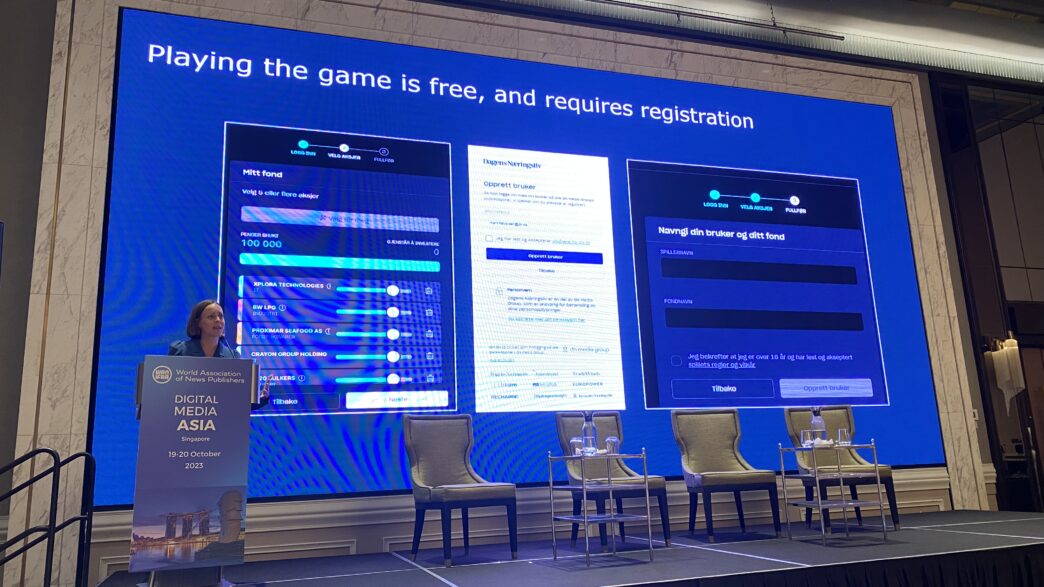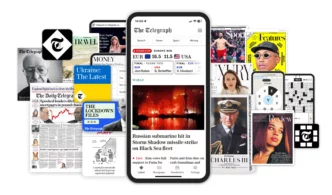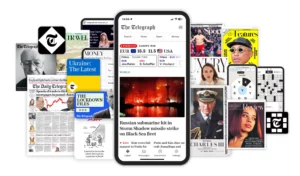

“Maybe young readers won’t subscribe now, but by building engagement we’re starting to develop the lifetime value of these readers ready for the future, when they might be ready to subscribe”
Marit Tronier Halvordsen, Head of Target Groups at DN Media Group – Norway’s leading business newspaper, recently spoke at WAN-IFRA’s Digital Media Asia conference about their new approach to young readers at the biggest publication in their portfolio: Dagens Næringsliv (DN). Instead of leading them through the classic conversion journey towards subscription, the goal is instead to engage them through gamification and de-anonymize them to collect data, target adverts and build brand loyalty to monetize in the future when they might be ready to subscribe.
The challenge
Financially interested young people are amongst DN’s most wanted target groups. And whilst their coverage of markets and the economy is very credible, this doesn’t quite cut it with younger readers.
Catering to younger audiences
The first step was to adjust their coverage and subscription offer to this younger audience, using a combination of qualitative and quantitative data to better understand the needs and preferences of this segment of readers.
- Adjusting coverage to appeal to younger readers – DN adjusted its journalism to better represent young people, ensuring their financial and economic reporting was covered in an “understandable” manner for those new to the industry
- Bringing the product to the reader – instead of waiting for young readers to find them, DN brought themselves onto university campus’, offering free access to students at selected universities whilst on campus.
- Discounted subscription – recognizing their financial constraints, readers under the age of 33 were offered a half-price subscription
The Gamification Solution
Whilst adapted subscription offers are important, DN saw the importance of engagement in a way that’s adapted to young readers, with the goal of informing these audiences and increasing brand loyalty so as to ensure they choose DN when ready to subscribe.
Specifically, how could DN teach young readers about savings and investments in an entertaining and engaging way?
For DN, the solution is to learn from the gaming industry.
Introducing, fantasy funds.
Working with their existing partner, Norkon, DN launched a stock market investment game in 2020 to appeal to young audiences.
“Just as the human brain is wired for stories, we’re also strongly inclined to engage with games. And with young people, who have spent their entire lives online, consuming information and playing games, this is the sweet spot for organizations that want to offer a hands-on financial experience, incentives to start trading in the real world, and encourage a new generation of investors to become customers or subscribers to their services.” shares Norkon
Fantasy Funds provide a risk-free opportunity for players to acquire stock market investment skills, combined with educational content and competitive elements with weekly and grand prizes, and the possibility to invite and compete against friends and colleagues. The repeated success of the game has led to new player registrations by the thousands.
- Anyone can register to the game for free and start playing in less than 2 minutes.
Registration is an increasingly important strategy for digital publishers, and games are a perfect opportunity to acquire registered members. By logging in, players will not only be able to have an account to save progress and invite friends, but the publisher can benefit from this data collection to personalize experiences across the site and target marketing campaigns to better engage and convert audiences.
- The game aims to acquire new readers through building bridges to content
The game not only covers the same topics as DN’s content, but also seeks to move readers through the funnel towards consuming written articles and higher levels of engagement – players receive regular newsletters and social media content on DN’s platforms that mix fantasy fund promotions with journalism to bring the two audiences together.
- Techniques from gaming help to develop engagement and loyalty
Making use of competitiveness to develop engagement – recency, frequency and volume of visits – is a clever strategy. At DN, they offer weekly prizes to players and reward an overall winner after each six-week game ‘season’ with a cash prize.
64,568 players, with more than half of them being new to DN
The introduction of gamification proved to be a game-changer for DN, with astonishing results:
- Over five game seasons, a total of 64,568 players engaged with the game, averaging between 13,861 to 25,366 players per season.
- An impressive 34,871 of the players were entirely new DN users, demonstrating the game’s ability to expand the newspaper’s reach.
- The average player visited the game pages 23.7 times, showcasing a high level of user engagement.
- The Fantasy Fund pages generated a staggering 11.7 million page views on DN.no, reinforcing the game’s success in capturing and retaining the attention of its target audience.
Best practices for succeeding in gamification
- Clearly define goals and target audience
Align the game’s goals with your overall strategy, whether that be to increase subscribers, maximize sponsorship opportunities, or increase the amount of traffic to your site for acquisition. Different games will benefit your brand in different ways, so defining goals is essential before getting started on gamification.
- Get internal buy-in from all departments
Ensure other departments are informed on your goals and strategy, and committed to the project. If other departments understand the strategy at play then they can work in the same direction, providing related projects to work towards the same goals.
- Tie the game to editorial
As outlined in this article, Fantasy Funds worked well for this financial newspaper as it allowed them to introduce their expertise on the topics of financial news, stock markets news, and business news. It’s important that the game aligns with the overall long-term strategy of the newspaper.
- Nurture young audiences
As we know, converting young readers to subscribers is a significant challenge for publishers – first salaries are unlikely to be spent on a newspaper subscription. However, with continuous nurturing and engagement, you can have a long-term plan in place and be ready to convert them when this audience has become more mature.
Conclusion
DN’s journey to attract a younger audience through gamification is a testament to the power of innovative thinking in the digital age.
By adopting gaming industry strategies and merging them with credible financial journalism, DN not only engaged a younger demographic but also gained nearly 35,000 new users.
This case study serves as an inspiration for media companies looking to rejuvenate their audience base while maintaining their core values. As other newspapers have turned towards gamification to generate new audience engagement strategies, the continuous success of the game reinforces that fun and education can go hand in hand, resulting in a win-win situation for both the newspaper and its younger readers.












